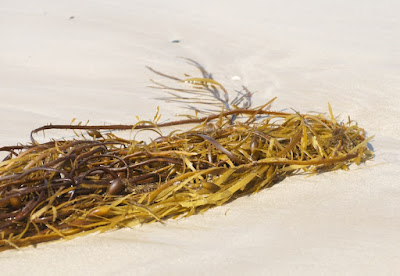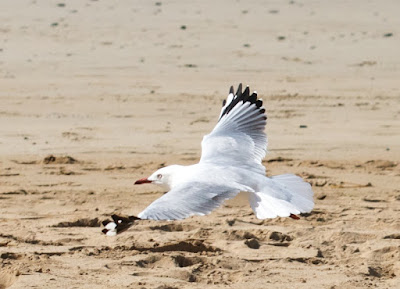For our last full day in Australia - March 29, 2014 - our friends Paul Pui and his wife Cho Gek Tan had a special treat for us: a drive southwest of Melbourne along the Great Ocean Road, perhaps Australia's most famous scenic route. The day deserves more than one post; this is the first of two.
Our first stop, at Point Addis, was a bit of a detour, but I had talked everyone into it in the hope of turning up a local specialty, the Rufous Bristlebird (Dasyornis broadbenti), which occasionally prances about the parking lot. Of course, it failed to do so when we were there. Nonetheless, the point provided us with some lovely views of coastal heath and oceanfront scenery.
At the seaward edge of the heath, where their thickened leaves can resist the salt spray from the nearby coast, sprawling clumps of Pigface (Carpobrotus sp.) cover the ground. Without flowers it is difficult to tell which species is involved: pigfaces of different types, both native and introduced, may grow together here.
Further inland, away from the spray, dense heathland vegetation dominates the landscape.
One of the heathland species is Scented Paperbark (Melaleuca squarrosa), its small leaves and dense growth typical of this sort of vegetation.
Ryan was much more interested in the beach itself (as any small boy would be).
Time to move on!
From Point Addis we returned to the main road, and headed off to the southwest. As we drove, the road began to follow the coast more closely. At one point we stopped to let Ryan and Paul climb down to the beach to check out a series of rockpools.
Here, the beach wrack included numbers of cuttlebones - cuttlefish must be abundant in the offshore waters. Notice the pale white shell of a ghost crab in the lower photograph.
At one point I found the carcass of a shearwater on the sand. I didn't check it carefully enough to be sure, but I suspect that this was once a Short-tailed Shearwater (Ardenna tenuirostris), a bird that breeds in huge numbers in Bass Strait.
Paul and Ryan, meanwhile, were checking out the rockpools (or tide pools, as we call them in North America).
Neptune's Necklace (Hormosira banksii), one of the more distinctive seaweeds, was as prominent here as in the rockpools we had visited in Tasmania.
Among the Neptune's Necklaces we found a variety of rock-loving mollusks, including Black Nerite (Nerita atramentosa) and Zebra Top Shell (Austrocochlea porcata).
Here are more nerites and top shells, surrounding an Orange-edged Limpet (Cellana solida).
Nerites of various sorts are common rock-pool snails in many of the warmer parts of the world, where they spend their time grazing on algae. I remember as a hold exploring tide pools in Jamaica encrusted with Bleeding-tooth Nerites (Nerita peloronta) - so-called because of the orange-stained, serrated edge to the shell opening, visible when you turn the shell over. The Black Nerite appears, indeed, to be entirely black, but the interior of its shell is white. It is found around much the Australian coastline, from Queensland southward to Tasmania and westward to Western Australia.
Further along the coast, the road rises along the tops of the sea cliffs, giving spectacular views of rocky, wave-spattered islets just offshore.
The view is particularly impressive from the Cape Patton Lookout, the high point on this part of the drive.
From here, the road drops down to parallel a series of sandy beaches - ideal places, once again, for inquisitive little boys.
The beaches are also good places for signing your name.
While Ryan wrote on the sand, I investigated the beach wrack - mostly clumps of Strap Weed (Phyllospora comosa).
This Pink Tellin (Tellina albinella) was another reminder of my youthful beach walks on the north coast of Jamaica (in the late 1950s!), except there the common species was the Sunrise Tellin (T. radiata). Tellins burrow into the sands just offshore - sometimes as much as a foot down - and their dead valves are common on tropical and warm-temperate beaches (where they are very popular with shell-craft makers, and it is easy to see why).
Other beachcombers than ourselves betrayed themselves by their tracks..
...or waited for us in person. These are Silver Gulls (Chroicocephalus novaehollandiae), the common gull over most of Australia.
Common though they are, they are highly attractive and, like all gulls, fun to watch as they go about their business.
Little groups clustered around picnickers on the beach, hoping for handouts (as gulls do everywhere...)
Ryan was not about to disappoint them (though I am not sure what he is offering them here).
On we drove, through a bit of coastal woodland - where I noticed a few photographers looking steadfastly up into a eucalyptus tree. That, in this part of Australia, likely meant only one thing - and for that, we definitely had to stop....
...and there it was, sitting placidly over our heads: Australia's quintessential animal, a Koala (Phascolarctos cinereus). In this shot it is showing off its unusual hind foot: notice that the big toe has no claw at all, but the second toe appears to be equipped with two. In fact what you are seeing are the second and third toes, which are fused together. Their two claws provide the Koala with a handy grooming comb (also useful for removing ticks).
There is a large population of Koalas in the coastal bushland along the Otway Coast section of the Great Ocean Road, one of the best places to to see one - still, a Koala encounter in the wild is a memorable experience, even if the animals themselves - lethargic creatures by day - don't actually do very much other than look back at you, or doze peacefully in the sun.








































No comments:
Post a Comment